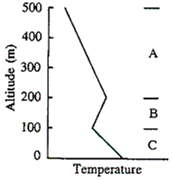Mixing
Refer to the figure below.

How many metres thick is the mixing depth?
A. about 0 m
B. about 100 m
C. about 200 m
D. about 400 m
Answer: B
Environmental & Atmospheric Sciences
You might also like to view...
What can you learn from air temperature?
What would be an ideal response?
Environmental & Atmospheric Sciences
Many of the poor on the periphery of cities in less developed countries live in areas known as
A) squatter settlements. B) council estates. C) public housing. D) the zone in transition. E) suburbs.
Environmental & Atmospheric Sciences
The most likely chemical evolutionary sequence for groundwater in a sedimentary basin would be:
a. sulfate, bicarbonate, chloride b. chloride, sulfate, bicarbonate c. bicarbonate, sulfate, chloride d. bicarbonate, chloride, sulfate
Environmental & Atmospheric Sciences
Which of these coastal processes does NOT shape both the shores of oceans and lakes?
aeolian forces B. sediment erosion C. wave action D. tidal shifts E. beach drifting
Environmental & Atmospheric Sciences